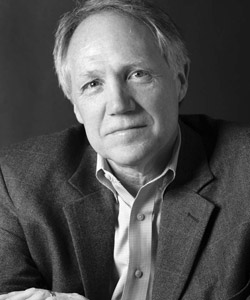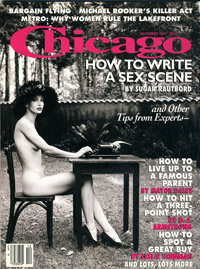
Richard Babcock Since Richard Babcock announced his decision to step down as Chicago‘s editor more than two weeks ago, there has been an outpouring of support and kind words for our beloved colleague. For many of us in the office, it’s been bittersweet to watch Dick (as he’s known to the staff) pack up his office and meet with writers and editors who have stopped by to wish him well. And while he’s not much for attention, we wanted to give our readers a chance to get to know our fearless leader of 20 years, so we invited our Facebook fans to post some questions for Dick. Here, his favorite Chicago magazine stories, advice for young editors, memorable reader feedback, and more:
What was your all-time favorite Chicago magazine story in the past 20 years?
—Mary Ann O’Rourke
Asking an editor to pick his favorite story is like asking a parent to pick a favorite child—you love them all in their own way. One of my proudest accomplishments here has been to deliver to our readers some of the best narrative journalism in the country. Many of those stories have been widely recognized and honored, so let me single out a few that (because of some marketplace alchemy that escapes me) never received the attention I think they deserved.
+ A Terrorist’s Tale, by Richard Cahan, February 2002
As questions heated up a decade ago about how American justice should deal with captured terrorists, Richard Cahan examined a forgotten footnote to World War II history—the saga of a young German American raised in Chicago who was arrested as part of a Nazi sabotage ring. Cahan’s account uncovered new information about a bizarre case that remains a key precedent in today’s Gitmo quagmire.
+ Heavy, by Robert Kurson, June 2001
Robert Earl Hughes of tiny Fishhook, Illinois, earned notoriety during his short life as the largest human on earth. Bob Kurson illuminates the sweet, wise, questing soul trapped inside 1,000 pounds of flesh. But students of great writing will recognize that Kurson’s insertion of a brief personal note elevates this story to a masterpiece.
+ Bound for Glory, by Jonathan Eig, January 1998
As Leon Forrest, a marvelous but sadly underappreciated Chicago writer, raced cancer to finish his final novel, he invited Eig, a former student, to sit at his side as he recollected his life. Eig’s loving portrait illustrates the deft touch he has gone on to wield in three books of his own.
+ Playing for Keeps, by Bryan Smith, February 2006
A handful of elderly men who hang out and play pool at a South Side rec center—you could hardly script a subject with less promise. But Smith turns the group’s ventures and repartee into an unforgettable reflection of life, family, friendship, and death.
+ Daley vs. Daley, by David Bernstein, September 2008
Though we ran this carefully researched comparison of father and son as a cover story, it seemed to get lost in the hurly-burly of the national presidential campaign then in full roar. For anyone interested in the last half a century of Chicago history, Bernstein’s analysis is required reading.
+ The Making of a First Lady, by Carol Felsenthal, February 2009
Another cover story that deserved more attention. Felsenthal’s profile of Michelle Obama offered by far the most penetrating examination published to that date of a woman who had quite suddenly been thrust into the spotlight. The fact that Michelle wouldn’t sit down for an interview opened the story up and gave it an edge that might otherwise have been lost.
What will you miss the most [about the job]?
—Chandra Greer
Having the opportunity (and resources) to pursue my curiosity—about people, civic life, events, whatever. In fact, it’s not just an opportunity, it’s a key part of the job description.
I am currently a college writing major. Is there any advice or tips you could give on the editing process?
—Natalia Lee
Be ruthless in looking at every sentence. Is the point clear? Could it be said more efficiently? With more wit and style? Then rewrite, rewrite, rewrite.
How has the city changed over your tenure?
—Kay Nola Lee
In some respects, Chicago has changed dramatically. It out-and-out looks different—with new buildings, new parks, more greenery; former stretches of desolation now brim with life. (Let’s be candid: Most of these happier changes are found downtown or close by the lake. Big, sad, interior areas languish in more desolation than ever.) Other changes slip in with more subtlety. All over the country, regional differences are being sanded away. With the great advances in communications, media, and travel, we are, in effect, neighbors with New Yorkers, Angelenos, everyone. I sense that the ingredients of Chicago’s distinction—the patchwork of neighborhoods, the native stores, the local accents, even our shared historical experience—are disappearing or being drowned out by the rising national clamor. But now I’ll shut up before I’m mistaken for King Lear.
 Did you receive any noteworthy letters to the editor in the past 20 years? Any reader feedback that surprised you?
Did you receive any noteworthy letters to the editor in the past 20 years? Any reader feedback that surprised you?
—Matt Paolelli
Your two questions dovetail around one of my biggest blunders. Our December 1993 issue featured a naked woman on the cover. Actually, she was situated to appear with more modesty than you regularly find in, say, a Calvin Klein ad, but some of the big stores were so wary of the public’s reaction that they refused to sell the issue. It became a giant newsstand dud. And a surprising (to me) number of subscribers complained, too. I remember one letter in particular. An outraged woman wrote to say, “We don’t allow any nudity in our house!” By then, I was so beaten down I could only send a flaccid apology. I didn’t have the gumption to ask: “So, how the hell do you take a shower?”
Photograph: (Babcock) Katrina Wittkamp


